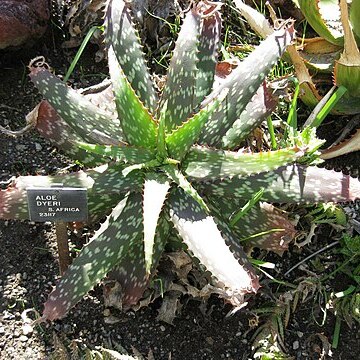Plants, usually solitary, acaulescent or with short stem. Leaves about 20, densely rosulate, lanceolate-attenuate, about 60-70 cm long, 10-15 cm broad at base, arcuate-spreading, gracefully recurved; upper surface canaliculate, green to yellowish-green, occasionally unspotted, usually with few or many very small elongated whitish spots varying from irregularly scattered to arranged more or less in interrupted undulating transverse bands; lower surface convex, pale green to greenish white, usually more copiously spotted throughout than the upper, the spots about 2 mm long, 1 mm broad, elongate, whitish, sometimes more or less arranged in transverse broken wavy bands, sometimes with a few indistinct longitudinal greenish lines especially near the margins; margins sinuate-dentate, with narrow semi-cartilaginous edge, armed with light-brown deltoid pungent teeth up to 5-6 mm long, 10-15 mm distant, the interspaces rounded. Inflorescence a branched panicle about 1.5 met. high (reaching 2 met. in very strong forms) usually rather compact, often 2 from a rosette, usually branched above the middle, with up to 15 branches the lowest of which sometimes with 2-4 branchlets producing a total of 30-40-50 racemes, the terminal the longest. Peduncle brown, lightly covered with a greyish powdery substance, flattened low down and up to 3-5 cm, diam., the branches often subtended at base by a large fleshy bract up to 12 cm long, 3 cm broad at base, with dentate margins in upper half. Racemes the terminal the longest, 20-25 cm, long, 9 cm diam., lateral racemes about 12-15 cm long, cylindric-acuminate, usually denser near apex, slightly laxer downwards. Bracts of lowest pedicels usually as long as their pedicels or slightly longer, narrowly deltoid-acuminate, thin, scarious, white, about 10-nerved, spreading to recurved, sometimes coiled in upper half. Pedicels lowest of terminal racemes 10-13 mm long. Perianth dull brick-red, averaging 35 mm long, with a basal swelling 9 mm diam., constricted above the ovary to 4-5 mm thence decurved and enlarging towards the throat (8 mm,), laterally compressed (5 mm), with the mouth somewhat roundly trigonous; outer segments free for 8 mm,, the free portion with whitish marginal border, obscurely nerved, the nerves confluent at apex, the apices sub-acute slightly spreading; inner segments themselves free, but dorsally cohering to the outer for their greater length, broader than the outer and with a whitish marginal border up to 2 mm broad, with 5-8 obscure nerves confluent at a somewhat light-brownish apex, the apices more obtuse, slightly spreading. Filaments filiform-flattened, the 3 inner narrower and lengthening in advance of the 3 outer, with their anthers in turn exserted up to 1 mm Style filiform, pale lemon, with the stigma at length exserted 1 mm. Ovary green, 8 mm long, 3 mm diam., finely 6-grooved. In shady creeks near Barberton plants flower in June, and when growing in dense bush the leaves assume a somewhat sickly green colour. At Waterval Boven, Schoemans Kloof and most other localities plants flower late in February to March, which is the usual flowering time for the species.
More
Plants usually solitary, stemless or short-stemmed, 400-700 mm tall excluding inflorescence. Leaves ±20, ascending or arcuate-reflexed, 400-700 x 45-150 mm, channelled, upper surface usually with few to many small whitish spots, irregular or in wavy transverse bands, lower surface more copiously and usually more regularly spotted than upper. Inflorescence with 15-50 ultimate branches, 1.5-2.0 m tall; racemes cylindric, lax; bracts deltoid-acuminate, 10-17 x 2-4 mm, many-nerved. Flowers glossy brick-red, 25-35 mm long, sub-clavate above basal constriction; outer segments free for 5-8 mm, inner segments free but adnate to outer; pedicels 7-17 mm long. Anthers not or hardly exserted. Ovary 5-8 x 2-3 mm, green; style exserted 1-4 mm. Fruit not seen.
Acaulescent or shortly caulescent herb, up to 0.7 m high, excluding inflorescence. Leaves with lower surface spotted, not lined. Bracts 7-many-veined, up to 17 mm long. Racemes narrowly conical. Flowers glossy brick-red.

